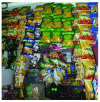Nutrition transition in South Asia: the emergence of non-communicable chronic diseases
- PMID: 26834976
- PMCID: PMC4706051
- DOI: 10.12688/f1000research.5732.2
Nutrition transition in South Asia: the emergence of non-communicable chronic diseases
Abstract
Overview: South Asian countries have experienced a remarkable economic growth during last two decades along with subsequent transformation in social, economic and food systems. Rising disposable income levels continue to drive the nutrition transition characterized by a shift from a traditional high-carbohydrate, low-fat diets towards diets with a lower carbohydrate and higher proportion of saturated fat, sugar and salt. Steered by various transitions in demographic, economic and nutritional terms, South Asian population are experiencing a rapidly changing disease profile. While the healthcare systems have long been striving to disentangle from the vicious cycle of poverty and undernutrition, South Asian countries are now confronted with an emerging epidemic of obesity and a constellation of other non-communicable diseases (NCDs). This dual burden is bringing about a serious health and economic conundrum and is generating enormous pressure on the already overstretched healthcare system of South Asian countries.
Objectives: The Nutrition transition has been a very popular topic in the field of human nutrition during last few decades and many countries and broad geographic regions have been studied. However there is no review on this topic in the context of South Asia as yet. The main purpose of this review is to highlight the factors accounting for the onset of nutrition transition and its subsequent impact on epidemiological transition in five major South Asian countries including Bangladesh, India, Nepal, Pakistan and Sri Lanka. Special emphasis was given on India and Bangladesh as they together account for 94% of the regional population and about half world's malnourished population.
Methods: This study is literature based. Main data sources were published research articles obtained through an electronic medical databases search.
Keywords: South Asia; Nutrition Transition; Epidemiological Transition, Non-communicable diseases; Healthcare.
Conflict of interest statement
Figures






References
-
- Barry M: Urbanization, Lifestyle Changes and the Nutrition Transition. World Dev. 1999;27(11):1905–1916. 10.1016/S0305-750X(99)00094-7 - DOI
Publication types
LinkOut - more resources
Full Text Sources
Other Literature Sources
Medical

